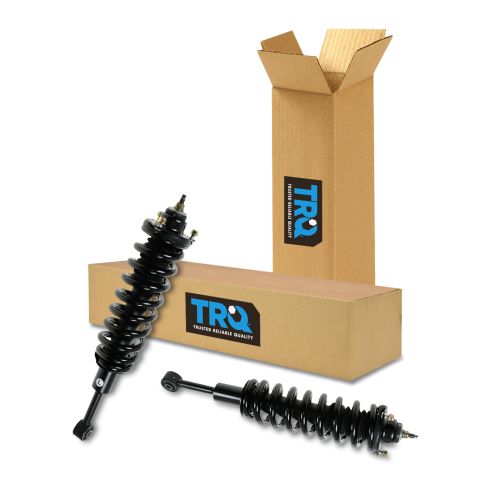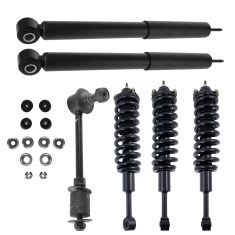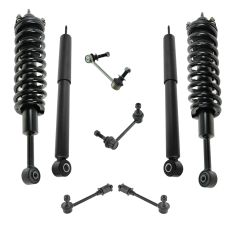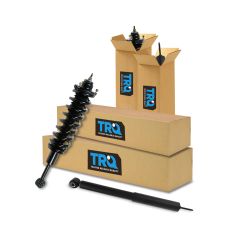1ASSP00409-Toyota 4Runner FJ Cruiser Tacoma Front Driver & Passenger Side 2 Piece Strut & Spring Assembly Set TRQ SCA57023

Replaces
2009 Toyota FJ Cruiser Front Driver & Passenger Side 2 Piece Strut & Spring Assembly Set TRQ SCA57023

Product Reviews
Loading reviews
4.86/ 5.0
22
22 reviews
Strut/shock delivery
January 2, 2018
I ordered a pair of loaded struts for a 2007 Toyota Tacoma. This was not the easiest part to find and the price from the dealer was outrageous! AND I would have had to buy 4 separate pieces, doubling my labor! I have been thrilled with A1 thus far and as long as they fit, will be using them quite a lot in the future!!
SJR
Owner
Cromwell Valley Motors
Just what I expected
July 30, 2018
I needed this strut/spring assembly quick and i paid a great price for it. It got here in 3 or 4 days and I installed them myself which went well. Only complaint is they are sagging a bit already after only having them on 2 weeks. Kinda what I expected for the price though. Also, the description says they replace Monroe quick struts, but they arent monroe parts. Its all the 1A auto brand parts. I dont even know why they say it replaces a monroe part when the truck came stock on bilstein 4600s, but in the end they work and thats all i was really needing.
May 7, 2020
worked fine
1A lever lets me down!
September 11, 2020
Fast, reliable service with 1A parts and customer service!
Great source for quality parts.
Doing great so far!
March 6, 2021
I purchased a set of these struts for my FJ Cruiser a couple weeks back. So far, they look and ride very nicely! Hoping for many miles and adventures to come!
Excellent service
June 6, 2021
Easy to use website very quick service and great prices fast shipping
August 20, 2021
Everything fit fine had no problems installing them.
November 10, 2021
These struts came as pictured I received them really quick Installum was not that easy but I got it done I would recommend buying stuff from 1A auto
FJ Cruiser front end parts.
November 27, 2021
Parts came exactly as advertised and in a very timely manner I will be happy to order from them again.
June 22, 2022
Good service and fast I recommend to buy and 1A auto
October 5, 2022
Great product
Fantastic struts!
[{"url": "https://wac.edgecastcdn.net/001A39/prod/media/pNISJll75W64CYGsite/5b2549439038cb37574cc2d75d7f811c_1671295723686_0.jpeg", "caption": ""}]
December 17, 2022
Perfect fit, the handling in my vehicle has definitely improved as my ole girl has 265,000 miles and the front struts were worn. Swapped these while doing my cv axles and they made such a difference. After one month they are holding up great!
New Struts and springs and a smoother ride!
[{"url": "https://wac.edgecastcdn.net/001A39/prod/media/pNISJll75W64CYGsite/68606f8d830ff30138d7042912fed142_1680974924157_0.png", "caption": "110,000 miles"}, {"url": "https://wac.edgecastcdn.net/001A39/prod/media/pNISJll75W64CYGsite/fee904b0ffb75171a898e9d608639d69_1680974924157_1.png", "caption": "When metal bolts become one!"}, {"url": "https://wac.edgecastcdn.net/001A39/prod/media/pNISJll75W64CYGsite/21b1c0a0ec64d9ca1bfb1f15f877d315_1680974924157_2.png", "caption": "Upper control"}, {"url": "https://wac.edgecastcdn.net/001A39/prod/media/pNISJll75W64CYGsite/f097d2ba4299f6c3850b4ccd3a1bd019_1680974924157_3.png", "caption": "Sheet metal modification!"}, {"url": "https://wac.edgecastcdn.net/001A39/prod/media/pNISJll75W64CYGsite/db6a91f75af95d080148b9508c0443e0_1680974924157_4.png", "caption": "Lower control arm \nAll parts fit great!"}]
April 8, 2023
Parts are good as new. Great fit!
And a great sense of satisfaction knowing that I didn't pay the stealership with the price of everything going up get your parts and get er done!
3/5 Stars for An Average Auto Part
[{"url": "https://wac.edgecastcdn.net/001A39/prod/media/pNISJll75W64CYGsite/93631c7480238025db4bdc958514a7f2_1684409967067_0.jpeg", "caption": "3/5 Stars for An Average Auto Part"}]
May 18, 2023
0/1 Stiff ride
0/1 Low quality compared to OEM
1/1 Perfect fit
1/1 Awesome price
1/1 DIY friendly and easy installation with YouTube video
Great struts
June 20, 2023
Great parts fit perfect it was very easy to install the strut thanks A-1
Shocking customer service!
[{"url": "https://wac.edgecastcdn.net/001A39/prod/media/pNISJll75W64CYGsite/c656f11e1874276840796d4bdc0e547d_1700318475169_0.jpeg", "caption": "Initial Condensation"}, {"url": "https://wac.edgecastcdn.net/001A39/prod/media/pNISJll75W64CYGsite/8f598a40d23c5c6bc004f764f739a89e_1700318501521_0.jpeg", "caption": "Condensation 2 weeks later"}]
November 18, 2023
I'll never forgive #1 Auto for not honoring the warranty on the two headlight assemblys that I purchased. The nastiest and rude customer service representive for #1 Auto told me that I was supposed change out the #1 Auto test light bulbs for new ones when I recieved my headlight assemblys that's why there was condensation in the one headlight assembly. What a fraud, it really takes your breath away when a company hires people like that to lie for them and make the customer go away so they don't have to honor their warranty.
How keep buying from 1a auto
January 2, 2024
Best price and free deliveries plus warranty
January 19, 2024
Exact fit. Installed easily.
struts
March 5, 2024
did the job and was a lot cheaper than paying dealer parts pricing
Just what I needed
June 16, 2024
Worked great
FJ Cruiser Front Schocks
July 15, 2024
Great shocks for the money. Still holding up great.
Fit my vehicle.
September 10, 2024
Fast shipping. Fit my vehicle. 07 fj manual transmission, 4x4.
Customer Q&A
Whom is the manufacturer of this product?
January 5, 2016
10
Hello, These are a 1A Auto house branded part/kit.
January 6, 2016
Brian F
10
The ones i received were FCS Auto branded
April 23, 2017
T H
Will they fit on a 2008 Toyota tocoma 2.7 liter access cab 2 wheel drive?
July 19, 2018
10
This part is specific to vehicles with a particular set of options. We will need more information about your vehicle to confirm the fit.
July 19, 2018
Jessica D
10
They fit my 2007 Tacoma PreRunner perfectly.
July 19, 2018
H H
Is this for 2x4 or 4x4?
March 9, 2022
10
I believe with the FJ Cruiser and 3rd gen 4runner the 2WD and 4WD use the same shocks and struts.
March 9, 2022
Anonymous S
10
It was on my 4x4 tacoma. Since sold that truck but these worked GREAT.
March 9, 2022
Samuel R
10
We would be happy to check. What is the year, make and model of your vehicle?
March 9, 2022
Andra M
Will these work on rear wheel drive 2004 4runner?
May 9, 2022
10
Yes, they fit mine
May 9, 2022
Veredah F
10
Yes they will
May 9, 2022
JOHN O
Does it fit a 2006 Toyota Tacoma 2wd 5 lug ?
June 22, 2022
10
Currently, we do not carry this part for your vehicle. We're always updating our inventory so please check back soon!
June 22, 2022
Kelly S
Are these compatible with adding spacers for a leveling kit?
October 11, 2022
10
Yes I have purchased them and put spacer on them
October 11, 2022
Todd M
10
Hello, our parts are a direct replacement to the originals and would not fit a modified vehicle.
October 11, 2022
Ricale A
Toyota is a registered trademark of Toyota Motor Corporation. 1A Auto is not affiliated with or sponsored by Toyota or Toyota Motor Corporation.
See all trademarks.













